Breast Reduction Scars: Are Mammoplasty Scars Permanent?
Body Plastic Surgery
Breast reduction is a major operation through which the surgeon reduces the volume of an overly large breast and improves its shape. Whether this surgery is done for aesthetic or medical purposes, it involves some degree of scarring, a common side effect of breast reduction. Although breast-reduction scars change in size and blend in with the natural skin tone over time, it is essential to know how to deal with them during and after recovery. This article briefly introduces the reduction mammaplasty procedure and provides useful tips on minimizing breast reduction scars.
What Is Breast Reduction Surgery?
People with large breasts often suffer from physical and emotional problems. As the leading causes of macromastia (which means large breasts) are genetic and hormonal problems, the patients cannot reduce their breast size significantly by dieting and exercising; therefore, they should undergo breast reduction surgery, also known as reduction mammaplasty.
However, many reconsider having mammoplasty because of its complications, especially scarring and bruising. The breast reduction scars will not affect its outcome and are mostly unseeable, but if you are obsessed with your skin’s marks, the following points may help you.
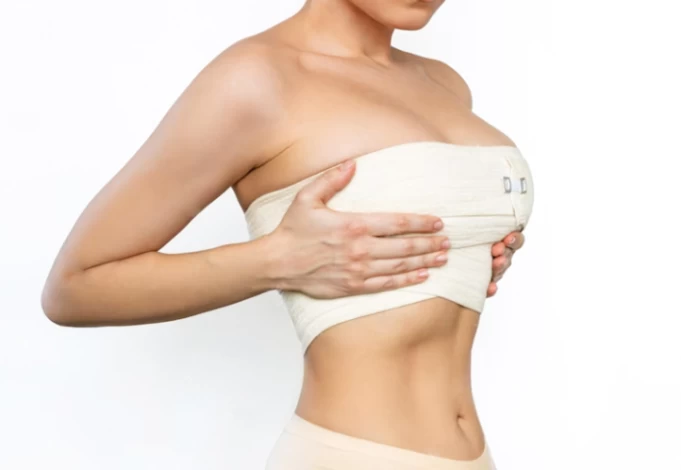
Types and procedure
Generally, breast reduction surgery involves two types of incisions: vertical cut (Lollipop) and inverted T (anchor-shaped). Both these techniques involve scarring, but in different places and extents. You can choose the best method according to your concerns and expectations.
Recovery
Depending on the extent of the mammoplasty and how well the body responds to this operation, it can take 2 to 8 weeks to recover fully. However, most patients can return to work 2 to 3 weeks after the surgery. The breast reduction scars will be red or pink during the first 3 to 5 months, but they will blend into the skin color and flatten over time.
Complications
The most common complications of breast reduction are swelling, bruising, scarring, and changes in the sensation of the breasts. Among the common side effects of this surgery only scarring takes a long time to heal. The mammoplasty scars are usually formed beneath the breasts and around the nipples and need extra treatments to be fully healed. In some rare cases also, breast reduction may lead to skin discoloration, infection, necrosis, nipple loss, and permanent loss of areola tissue.
Types of Breast Reduction Scars
As mentioned, two types of incisions can be made in breast reduction surgery: lollipop and inverted T.
Short-scar technique
In this method, commonly known as lollipop or keyhole incision, the surgeon makes a horizontal incision around the areola and a vertical one down to the breast crease. This method is mostly suitable for those with moderate sagginess, who want more minor changes (reducing one cup size), or who are highly concerned about the scarring after breast reduction.
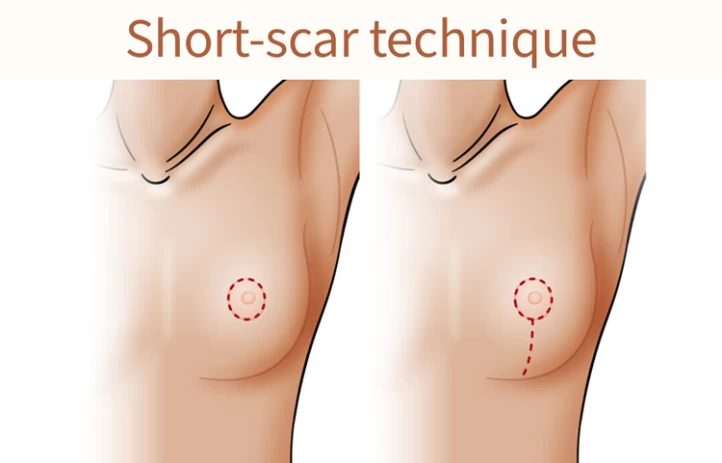
Large-scar technique
The inverted T or anchor-shaped technique involves three cuts. The first cut is made around the areola; the second one is made from the nipple to the breast crease, and the third one is made horizontally along the crease. This type of mammoplasty is mainly offered to patients who require major fat and tissue removal (two or three cup sizes) or have too saggy tits.
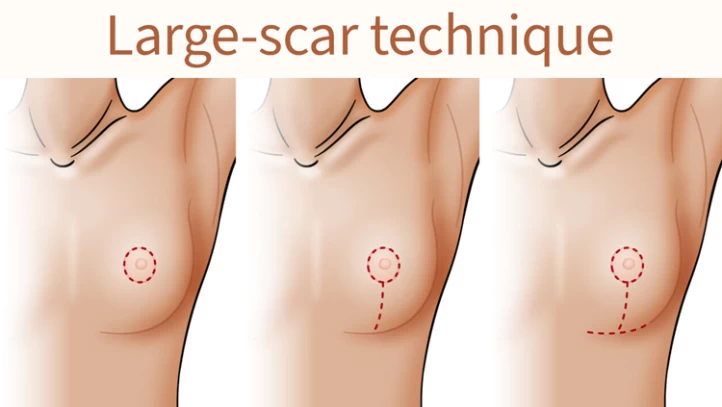
Breast Reduction Scars Over Time
Fortunately, most breast reduction surgery scars get pale over time or can be concealed by clothing or a bikini. Read on to learn more about what happens to your scars during the first year after reduction mammaplasty.
After three months
Your wounds are covered by bandages for a couple of weeks after the operation, so you will not see how your skin is healing. From the third or fourth week after the surgery, you can see red or purple scars around your areola and under your breast crease when the bandages are removed. The scars are thick and elevated for almost three months following the mammoplasty.
After six months
Six months after the surgery, your breast reduction scars are paler and less prominent. If you have a dark skin tone, your scars look quite lighter than yours, and if you have a light skin tone, your scars are probably pink or light red.
After a year
Most scars blend with your skin tone within a year if you have good skin quality. However, some people may have to deal with their breast reduction scars for years. Suppose you have a history of severe scarring. In that case, it is suggested to consider breast reduction scar treatments like laser therapy or chemical peeling to help your scars heal faster and better.
What Does the Breast Reduction Scar Look Like?
The scars of almost all plastic surgeries are the same. After the breast reduction surgery, you will have a red or pink scar around the areola and under your breast, which will get paler within a year. If you have a dark skin tone, you are more at risk of developing atrophic scars and hyperpigmentation. Hypopigmentation may also occur in people with lighter skin, making the scars lighter than the skin color.
The size of the breast reduction scar mainly depends on the technique used during the operation. Although most scars can be concealed behind a regular bra or bikini top, the scars of the inverted-T method are larger and more prominent than those of the lollipop method.
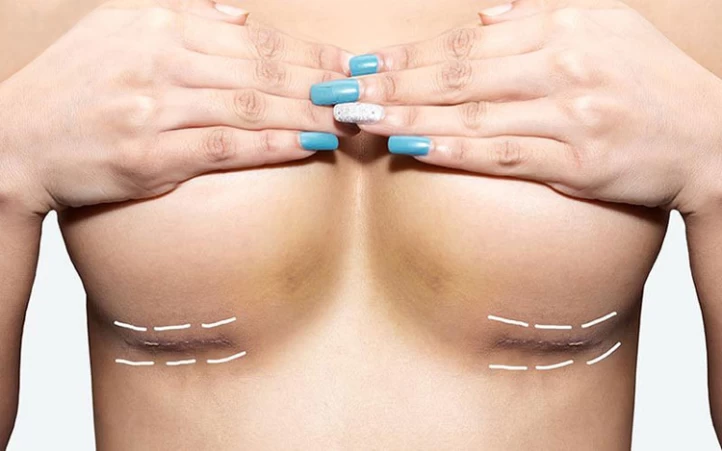
General Tips to Reduce Scarring After Breast Reduction
While your breast reduction scars won’t go away completely, they will fade into your skin tone to a great extent. Meanwhile, you can consider the following points to minimize breast reduction scars faster:
- Follow your surgeon's instructions about how to take care of your wounds;
- Use your surgical bra and bandages for as long as your doctor has suggested;
- Avoid weight gain as it can make your scar tissue wider;
- Do not scrub or scratch your scars as they get worse;
- Avoid stress and anxiety because they can hinder your wound-healing procedure;
- Avoid smoking and drinking alcohol as they affect the collagen production in your body;
- Avoid sunbathing, UV rays, and tanning beds;
- Take your antibiotics on time to prevent wound infection;
- Avoid using makeup products to conceal your wounds;
- Refrain from using OTC ointments and creams as they may interfere with your healing procedure.
How to Minimize Breast Reduction Scars?
Right after reduction mammaplasty, the surgeon provides useful instructions on caring for your wounds on the days following the surgery. By following these instructions, your scars will heal better and be less apparent; however, you probably still need the following breast reduction scar treatments.
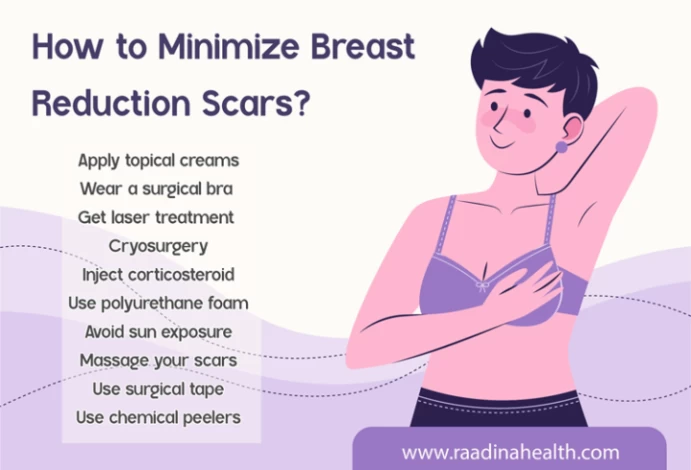
Apply moisturizers and topical creams
Applying moisturizers and creams containing vitamins A and E can improve the healing process and make the scars paler. Remember that the moisturizers you use shouldn't have alcohol, paraben, or fragrance, as they may cause infection.
Use silicone gel and sheets.
Using silicone gels, sheets, and ointments can prevent the formation of breast reduction keloid scars, reduce swelling, and minimize skin irritations such as redness and itching.
Wear a surgical bra and embrace dressings.
After the surgery, the surgeon warps your breasts with a surgical bra to tighten your chest's skin and keep the breasts in their new position. Wearing the right bras during recovery speeds up healing and reduces noticeable scarring.
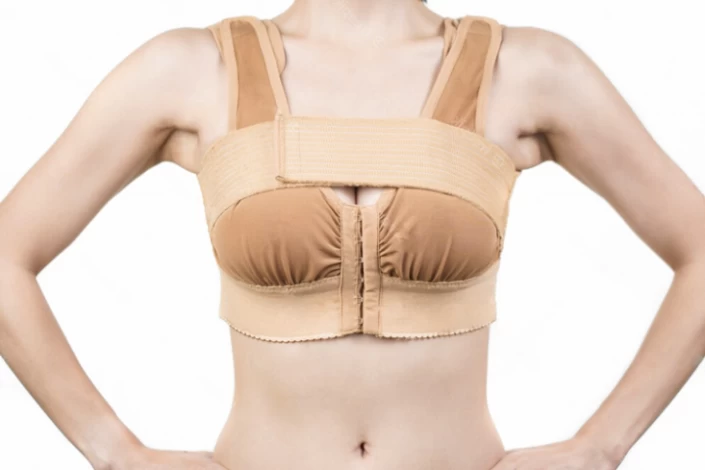
Get laser treatment
If the breast reduction surgery scars are large and bumpy, you probably have to get laser treatment to reduce the appearance of scar tissue. Although such breast reduction scar treatments are costly and may not be covered by insurance, they can significantly minimize the scars.
Cryosurgery
In cases where hypertrophic scars and keloids are formed on the skin, dermatologists offer cryosurgery. In this novel therapeutic technique, the doctor freezes and destroys the scar tissue by injecting liquid nitrogen into its core.
It is noteworthy that cryosurgery is more effective during the early stages of keloid formation, so ensure you get this treatment right after your wounds have healed.
Get surgical treatment
Surgical treatment is the most invasive method of minimizing breast reduction scars. In scar revision surgery, the surgeon cuts the scar tissue completely or uses skin grafts to restore the damaged skin.
Inject corticosteroid
Corticosteroids are anti-inflammatory medicines that can reduce the size of breast reduction keloid scars to a great extent. They also help minimize the surgical site's itching, redness, and burning sensations.
Use polyurethane foam
Polyurethane is a sterile, soft, absorbent foam covering the scars and preventing excess skin from forming on and around the wound. It also provides necessary moisture for the wound, hindering keloid scars' proliferation.
Avoid sun exposure
Direct sunlight can turn new scars into mature ones; therefore, it is necessary to avoid sun exposure for at least six months following the surgery. If you have an outdoor job, cover your wounds with clothing or bandages before leaving.
Massage your scars
Massaging your new scar tissue can increase the skin's collagen and elasticity and reduce the itching and burning sensation in the operated area. You should rub your scar tissue horizontally, vertically, and circularly with your fingers three times a day for at least four weeks.
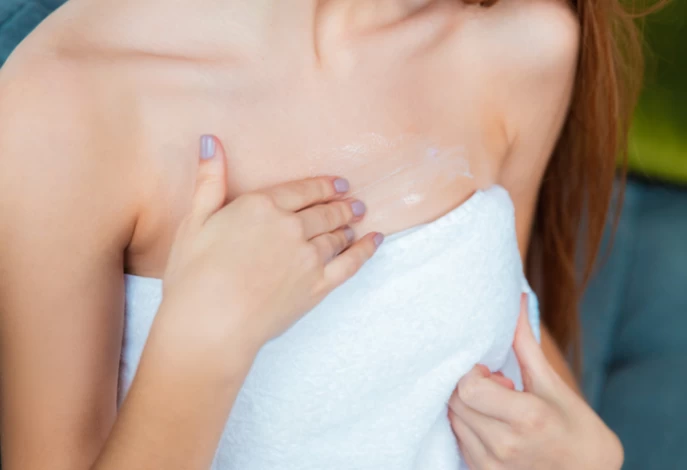
Use surgical tape
Surgical tapes (or steri-strips) are less common breast reduction scar treatments. However, using them during the first two weeks following the surgery keeps the incisions closed and promotes healing.
Use chemical peelers
If your breast reduction surgery scars are not atrophic, the dermatologist may offer chemical peeling techniques to remove the outer layer of the scar's skin. This helps shrink the scar and makes it less apparent.
Where Do the Scars Form After Breast Reduction?
The location and extent of breast reduction scars depend on the technique employed during the operation. In the lollipop method, the largest part of the scar is located under the areola, with only a small horizontal scar around the areola.
In the inverted T method, however, there would be a larger scar along the breast crease and a minor one on the areola. The scars of reduction mammaplasty can be concealed entirely under an ordinary bra or swimsuit.
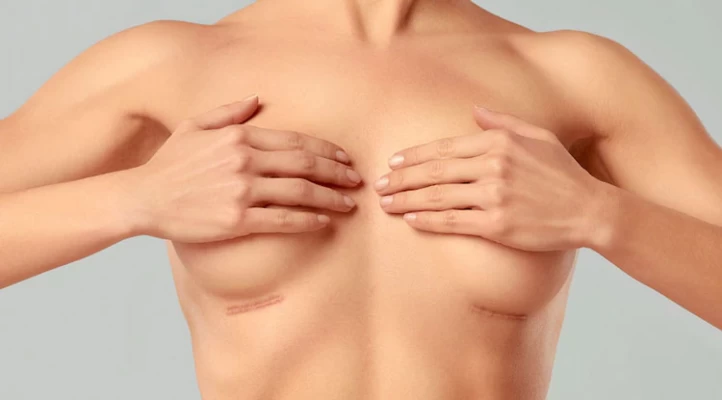
How to Get Rid of Scars Around Nipples?
Although the surgeons make incisions in the less-apparent parts of the breasts, you should expect minor scarring around the nipples. It may take 6 to 8 weeks for these scars to fade; however, you can get rid of them sooner by trying topical ointments, steroid injections, laser therapy, and massaging.
Do Breast Reduction Scars Go Away?
Generally speaking, breast reduction scars do not go away independently and require additional treatments such as laser therapy or corticosteroid shots. However, the scars get paler and thinner as time passes, and, in some cases, they are hardly visible a year after the surgery. Make a mental note that the treatment and development of breast reduction scars highly depend on your skin type, genetics, and how well you care for your wounds.
Are Breast Reduction Scars Avoidable?
Scarring is an inevitable complication of breast reduction surgery. Still, if you have a history of developing atrophic scars or are too concerned about the effects of scarring on your final results, you can undergo liposuction breast reduction.
During this surgery, only two small cuts are made on less-visible parts of your body, and a cannula suctioning device sucks out fats. Although liposuction is less invasive and has a shorter recovery period, it only removes fatty tissues from the breasts, not the glandular ones. So, if you do not expect significant changes after reduction mammaplasty, liposuction can be a proper technique for contouring your breasts.
FAQs About Scarring After Breast Reduction
1) What factors worsen breast reduction scars?
Smoking tobacco in any form, tanning, scrubbing, using OTC medications and ointment without your doctor’s permission, and scratching the wounds can adversely affect the breast reduction surgery scars.
2) Will breast reduction scars be itchy or painful?
Your wounds will be itchy or painful during the first weeks after the surgery, but once the scars are formed, they won't be itchy anymore. However, some keloids and atrophic scars may be painful when touching them.
3) Can I get a tattoo over my breast reduction scar?
Yes, but you must wait until your mammoplasty wounds are completely healed.
4) How long does it take for breast reduction scars to go away?
Since each body has its unique pace of healing, we cannot say when exactly the scars will go away. It generally takes 6 to 12 months for non-atrophic scars to go away. This time will be shorter if you use extra treatments such as laser therapy or chemical peeling.
5) I have dark skin, and my breast reduction scars are very bright; what should I do?
Breast reduction scars on black skin will be more vivid, especially when they are new, but as time passes, they will blend into the skin tone. If a year has passed since your surgery and your scars are still obvious, you may need laser therapy or chemical peeling.



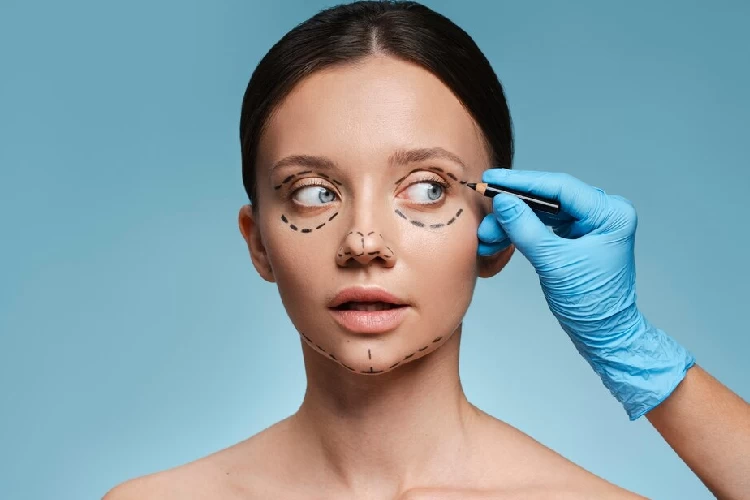
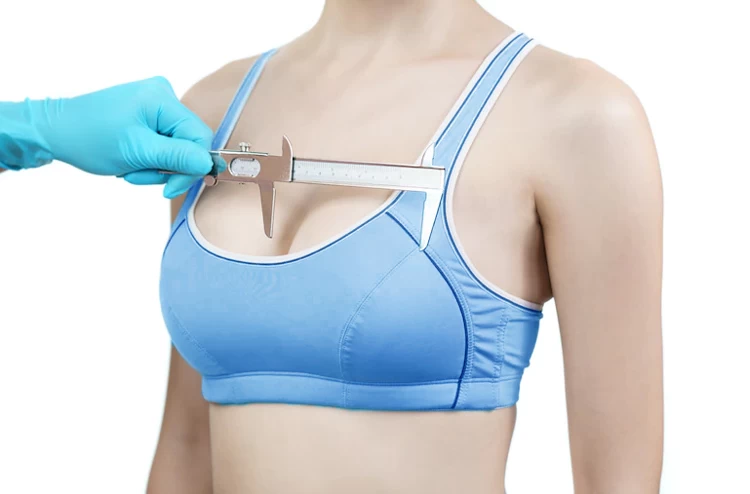
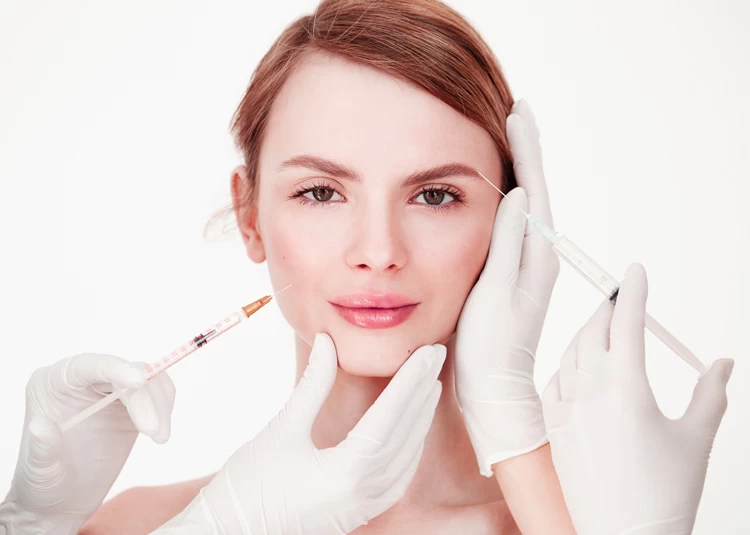
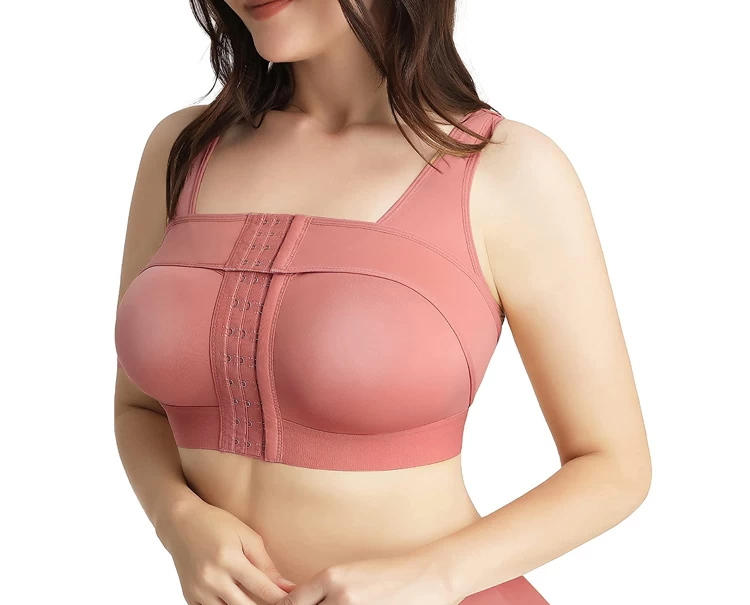
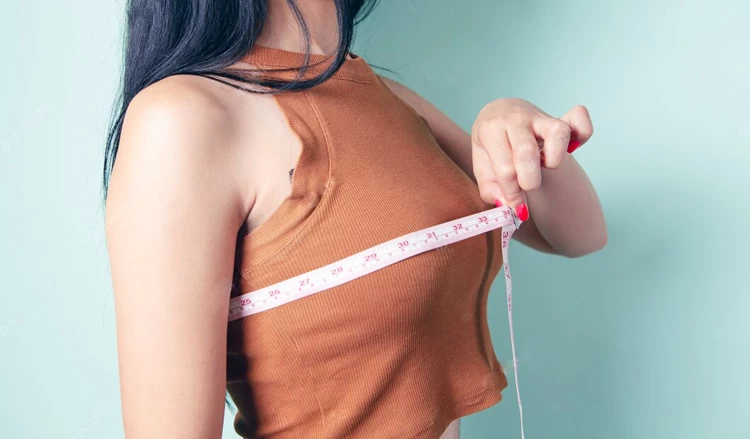
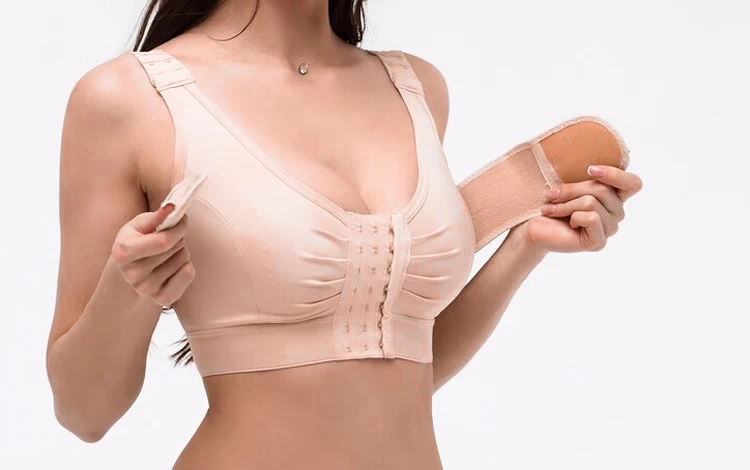

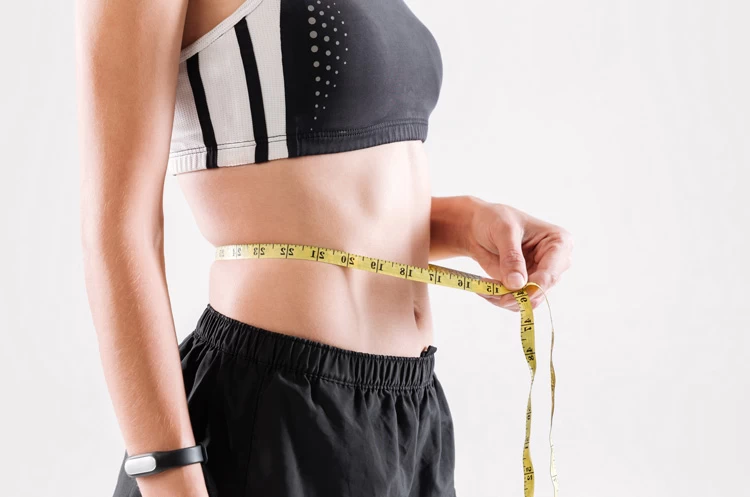
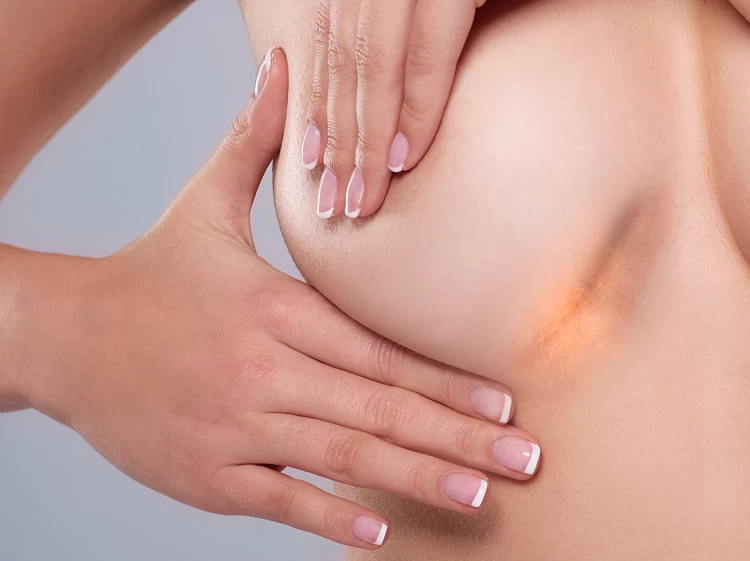

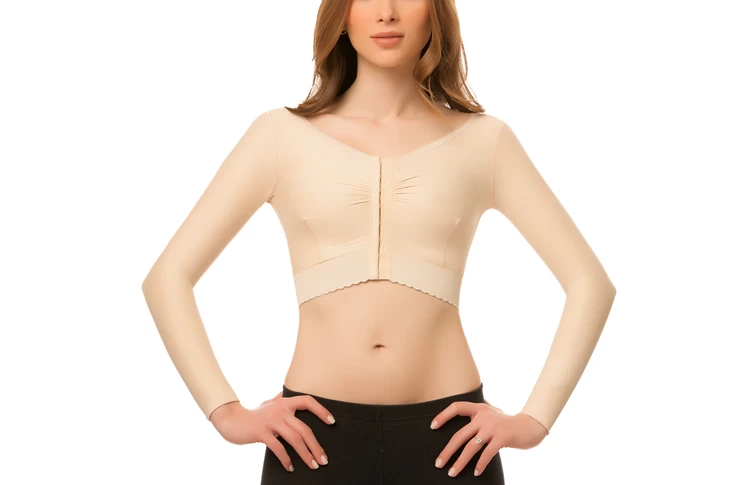
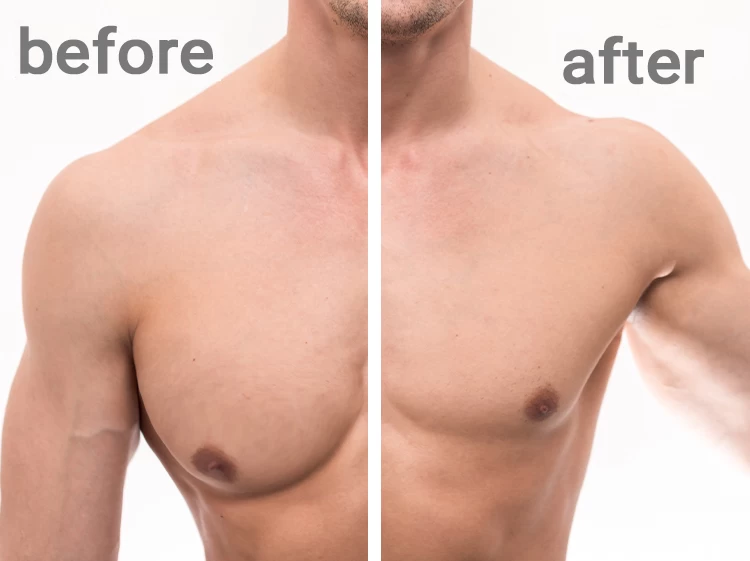

No reviews
Your comment